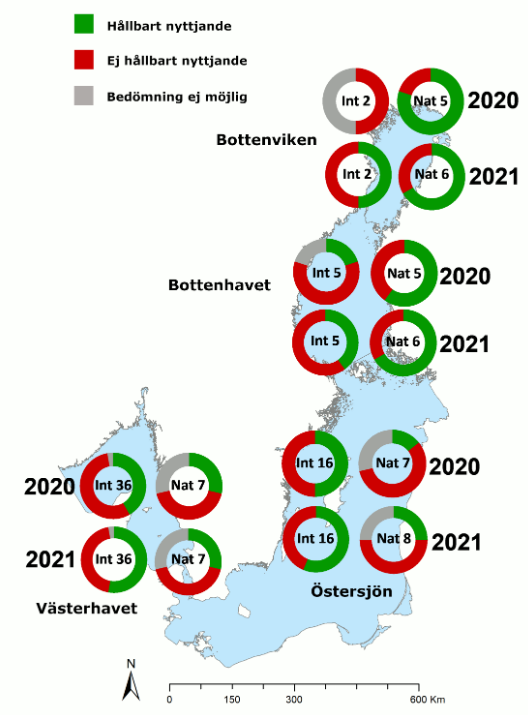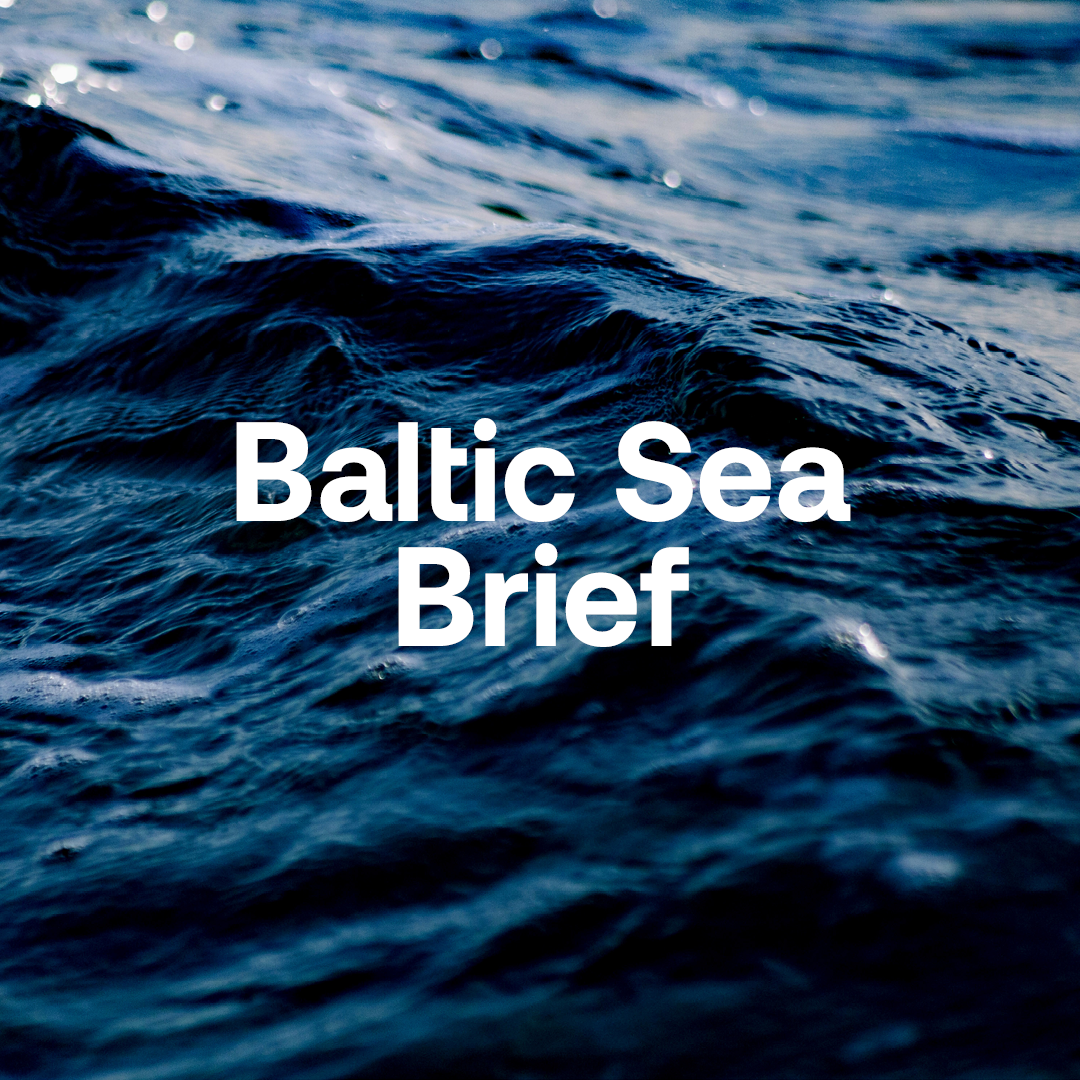2023 advice on Baltic Sea fishing opportunities
The International Council for the Exploration of the Sea (ICES) has published its 2023 advice on Baltic Sea fishing opportunities. This advice serves as the basis for negotiations on next year’s quotas and the Commission’s quota proposal to be considered by the Council of Ministers later this autumn. Although the advice is important, it should be used with high caution. It is essential for coastal fishery and the ecosystem that the government commit to reducing quotas in the Baltic Sea.
Time for Baltic states to take responsibility
After the cod collapsed in 2019, much focus has been on the negative trend for herring. A collapse of herring similar to that of the cod would have irreversible consequences for the Baltic Sea. The Swedish Minister of Rural Affairs, Anna-Caren Sätherberg, has received clear messages from the Department of Aquatic Resources, the Baltic Sea Centre and from a unanimous parliament on the need to take forceful measures. The lack of herring affects many people living along the Baltic coast, and industrial fishing is now under enormous criticism in Sweden.
Only Baltic state governments and fisheries ministers can negotiate within the EU to limit the 2023 quotas and begin the long-term process towards a revised fishery policy. To achieve the environmental goals, Baltic Sea fish stocks must be protected. It is time for the government to prioritise the environment over the fishmeal profits of a handful of industrial trawlers. In Sweden over 90 per cent of the total catches goes to the fishmeal industry.
Will we let history repeat itself – again?
Baltic cod stocks have not recovered. The ICES advises a quota of 943 tonnes for the western cod stock, and continued closure for the eastern cod stock. Now history is repeating itself with the herring: Warnings are not taken seriously, a single year of perceived improvement in recruitment is used as a pretext to increase quotas, and alarming changes in age and size distribution are not taken into account.

Graph: Catches of cod (blue) and herring (yellow) in central Baltic (number of tonnes). Source: ICES. Cod (Gadus morhua) in subdivisions 24–32, eastern Baltic stock (eastern Baltic Sea)Herring (Clupea harengus) in subdivisions 25–29 and 32, excluding the Gulf of Riga (central Baltic Sea)
Uncertainties about the herring call for drastically reduced quotas
- Severe reduction over a long period. Baltic Sea herring stocks have been severely reduced in the past decades. The central Baltic herring stock has decreased over 80 per cent since the 1970s, and the Gulf of Bothnia stock and the western stock have fallen over 50 per cent and 80 per cent, respectively, since the early 1990s. The shortage of Baltic herring along the coasts has become very apparent in recent years.
- Poorly differentiated management. Baltic Sea herring are managed as a single population, when there are in fact several different populations that have adapted to different habitats.
- Inadequate consideration of age and size distribution. Just as with cod, the shortage of large herring is an ominous sign of a stock in crisis. Management is focused on biomass, which takes no account of size and age distribution. This is of no interest to industrial fishing since everything is made into fishmeal.
- Unreliable assessment of recruitment. ICES recommendations regarding recruitment (1-year-old fish) vary between years for the central Baltic and the northern part of the Gulf of Bothnia. A single year of stronger recruitments should not be used as a pretext for increasing quotas, as the assessment can change in future years.
- Industrial fishing is unprofitable for state and society. Industrial fishing is insignificant in terms of job opportunities and does not have a positive effect on the economy of local coastal communities. Meanwhile, it incurs major social costs (over €55 million per year in Sweden) and has few other positives, as 90 per cent of the herring in Sweden is fished by 20 industrial trawlers and turned into fishmeal in Denmark.
At least 50 per cent lower quotas
The Baltic Sea Centre at Stockholm University proposes adjusting quotas to the scientific uncertainty and setting them at a maximum of 50 per cent of the Maximum Sustainable Yield (MSY). This would involve a drastic change to the quotas, and be an important step towards a new approach to MSY and risk reduction. At the same time, fishing for one species needs to take greater account of other species that may be affected – herring and sprat, for example, are the cod’s most important food source, and fishing for these species can therefore hinder the cod’s recovery. Read more on Stockholm University’s website.
MSY, B, Y and F – a glossary
B = Biomass: Total weight of a fish stock. Takes no account of age, size or gender distribution.
Y = Yield: Fish taken from the water by fishing.
F = Fishery mortality rate: Catch size as a percentage of stock size.
MSY = Maximum sustainable yield: The largest yield (catch) that can theoretically be taken from a stock.
BMSY = The biomass that enables the maximum sustainable yield. The surplus biomass produced is MSY, the maximum that can be harvested without reducing the population.
FMSY = Maximum rate of fishery mortality resulting in a population size of BMSY.
A stock is overfished when the biomass is below BMSY and when fishery exceeds FMSY.
Finally, fishery management must begin taking the preservation of large individuals into account. This has been a criterion of the Marine Strategy Framework Directive since 2008. The fact that this is still being disregarded encourages overfishing and is a contributing factor to today’s difficult situation for coastal fishery and the Baltic ecosystem. The Swedish Agency for Marine and Water Management (SwAM)) also recommends that the precautionary approach be applied:
’In the absence of internationally agreed threshold values for a favourable size distribution to supplement current MSY goals, SwAM recommends that, pursuant to the precautionary approach, fishing opportunities for herring in the central Baltic be established to set the fishery mortality rate on a level below the lower portion of the F interval for MSY (FMSY lower).’ (HaV 2022-03-31 Dnr 1:2021)
| Area | Quota 2022 | ICES rec. 2023 | FMSY Lower | BW2030 50% |
| Herring, central Baltic | 82,015 tonnes | 95,643 tonnes | 70,130 tonnes | 49,077 tonnes |
| Herring, Gulf of Bothnia | 111,345 tonnes | 102,719 tonnes | 80,047 tonnes | 51,360 tonnes |
| Sprat | 295,300 tonnes | 249,237 tonnes | 183,749 tonnes | 124,819 tonnes |
Source: ICES Advice 2022
Environmental goals not being met
To understand these recommendations, one must bear in mind that ICES advice focuses on commercial species and potential catches of commercial fisheries. This is why catches in the Baltic have not been sustainable.
The 2008 Marine Strategy Framework Directive, which forms the basis for achieving good environmental status and good ecological status in the seas and oceans, established goals to be achieved by 2020. The same goals are included in the EU’s Common Fisheries Policy.
For Sweden, the directive is implemented through a marine strategy that is monitored and renewed in six-year cycles. Unfortunately, this has not improved the situation for Baltic Sea fish, but has mainly meant that politicians are always able to refer to a forthcoming strategy, plan or cycle when goals are not achieved. In Dagen Nyheter’s thorough review of environmental targets, Professor Erland Mårland comments on environmental goals in general: ‘You establish a goal, figure out how it will be measured, then check it off … It is also politically convenient to manage these huge problems by setting goals to be achieved down the line. Then you don’t need to take the tough, necessary decisions during the current term of office.’
Sweden has 16 environmental quality goals, including ‘Sea in balance and living coast and archipelago’. The government has added 11 specifications to this goal, some of which involve fish stocks and fishery. In its annual evaluation of Sweden’s national environmental goals, the Swedish Environmental Protection Agency found that ‘Good Environmental Status’ in the sea has not been achieved for reasons including ‘Long-term unsustainable fishing’. In the Ecosystem Services area, the agency found that the share of sustainably used stocks is decreasing.

Use of fish and shellfish stocks, 2020 and 2021. Percentage of assessed stock.
Int = internationally managed stock
Nat = nationally managed stock
Green: Sustainable used
Red: Not sustainably used
Grey: Unable to assess
Source: Sweden’s environmental targets and SwAM
In Baltic Sea Brief 38 we wrote about the difference between talk and action when it comes to fishery policy. The fishing quotas established each year are basically the only concrete action taken. Other than that, the importance of fish stocks to the Baltic’s environment is no more than empty talk – mainly in the form of goals that are set and moved forward in time, but never achieved.
The ICES’s advice is therefore clearly linked to environmental goals and fishery – particularly industrial fishing, which needs to be stopped to protect the Baltic’s ecosystem. The Swedish government now has the summer months in which to actively urge the other Baltic Sea countries to decide on drastically reduced catch quotas, a requirement that BalticWaters has highlighted, along with coastal fishermen, county administrative boards, the Department of Aquatic Resources, the Baltic Sea Centre and other stakeholders.

